A Whistle Stop Tour of Lemnos!
Myrina has been an absolute delight. After a few days, I felt as though I’d settled into the rhythm of the place and began to feel completely at home. All the difference has been made by my wonderful host at Apollo Pavillion Hotel. Lucy has made me feel very welcome and nothing is too much trouble. Lucy’s door to the office is always open and she is available to answer any questions or queries or even to just sit and have a chat. I discovered that Lucy is Egyptian and as my husband is Egyptian we had plenty to talk about.
Although there have been enough places for me to go and explore in Myrina, I was conscious that Lemnos had so many exceptional things to see and it would be an absolute travesty if I couldn’t at least see some of them. As mentioned in my previous post there isn’t really a workable bus service for tourists on the island. There are upcoming elections on Sunday and there has been a lot of activity in the town campaigning for the new Mayor. One candidate has pledged to put on a bus service during the season that would serve tourists. We will see.
Anyway, being confined to Myrina was great but getting out and about to see a little more was like an itch that needed to be scratched. If anyone could help me find a way to do it, it would be Lucy.
One afternoon I went to see her in her office which is an extension to her beautiful home. I asked if there was a way to see a bit more of the island that didn’t require me to hire a car. She gave it some thought and then picked up the phone and had quite a lengthy discussion with someone on the other end. Lucy told me that she had just spoken to a lady called Sophia who owns both a taxi company and a car hire company. She is very trustworthy and could could take me to some of the key places of interest the following day. We agreed on a price and a meeting time, so the plan was set.
The following day Sophia arrived at the hotel. We sat down together with Lucy and sketched out a plan of the places to visit. The place at the top of my list was Panagia Kakaviotissa, the church in the cave. If I could see this alone I would be happy.
Off we set, taking the road out of Myrina. Panagia Kakaviotissa is the first on our list. We arrive at an empty car park at the end of a long dirt track. Although, Sophia is a truly established Lemnian resident she hasn’t visited the church before. She has brought visitors to the car park of the site but has never made it up there herself. Today, to my delight she has decided to embark upon the adventure with me!
As this is the first time for both of us, neither of us knows what to expect. For those that follow Peter Manaes’s series My Greek Odyssey, despite his huffing and puffing at the top of the steps, he made it look quite easy! At the start of the climb, there are many sets of stone steps set amongst the natural crags leading up the side of the mountain. It felt like at every turn you would expect to catch sight of the church but instead, you were presented with yet another set of steps.
We got the feeling that there were eyes watching our every move!
Sophia told me that some people have got married at the church and we joked that we can’t imagine the bride making this climb in her beautiful white dress and heels! Maybe she got airlifted onto the top of the mountain, or perhaps she made the ascent in joggers and trainers and got changed and beautified once at the top. Who knows. I’d love to know the logistics of conducting a wedding up here.
When we eventually make the final steps on the side of the mountain, the landscape begins to plateau. The views from up here are pretty spectacular though with the sun in front of us, the photographs don’t do it justice.
Unusual rock formations jut out at every angle, looking like tiny cathedrals. There is still no sign of the church but we continue to follow the path across a scrub-covered landscape.
Sophia told me that the prickly scrub that has now turned an autumnal yellow, is covered in purple flowers in spring. In English it is called Thorny Burnett and in Greek, it is known as αστνή or αστοιβή. It grows densely to nearly waist height but a path has been cut right through it, marking the way to our destination. Now I can imagine a bride walking amongst the haze of spring flowers. What a sight that must be. There is a well-known Greek song about this plant and Sophia sings this as we weave our way along the path. Goats scatter as we disturb their peace. Honestly, it is such a privilege just to be walking in this unique and beautiful landscape.
By now it seems as though we have almost circumnavigated the mountain. We tried to work out the position of the moon that was still visible in the sky but clearly, neither of us had paid attention to what we may have been taught as girls scouts! However, as reach the end of the thorny path, we can see a sign that we may have reached our destination – almost! In the distance we can see another set of stone steps above which there is some kind of scaffolding and a platform – but still no sight of the church which is still well and truly hidden.
Up the last set of steps we climb and finally, the jewel in the crown of the mountain slowly reveals itself. We are both awestruck.
We take a few minutes to absorb the sight in front of us. A very simple roofless church constructed with hand-hewn stone and adorned with icons and offerings. Once inside the gate, I hear Sophia gasp. To the right, there is a display of hair bands and caps, a collection of cherished personal possessions once belonging to someone who has now passed on. A little part of them now resting in the arms of Panagia Kakaviotissa for eternity. A simple but very moving sight.
On the face of it, the construction of the church is a simple stone wall housed in a cave but even as an atheist, I can feel a very powerful spiritual presence. It really is something quite special. We are thrilled to have made it.
After spending some time soaking the experience all in it’s time to make our way back. Climbing up was one thing, but as an acute vertigo sufferer, getting back down is another matter. Climbing back onto the elevated platform is the worst bit but I sit on the steps and shuffle down on my derierre until I’m at a level that’s bearable. It’s not an elegant sight but needs must!
Walking back through the landscape we pass a young man. We greet him and he stops to exchange a few words with Sophia before going on this way. His family own the goats that roam the mountain but he is going to the church to pray. Tomorrow he has a serious operation and he is asking for protection from God for the procedure.
Just as we take the final descent back to the car, we pass another couple, an elderly lady and her grandson. She is walking with a stick which considering the uneven nature of the terrain is a brave choice. The Greek Australian man tells us that she is determined to make the climb and visit the church. I hope that she makes it.
Back in the car, we make our way along the track passing a cluster of beehives. I’ve already heard that Lemnos honey is some of the best so I’ll be sure not to leave the island without any. We take the road up above the village and the wide bay of Plati where we make a quick stop for a photo.
Leaving Plati, we head towards the village of Kontias passing pretty stone windmills along the way. The houses of the village of Kontias are also beautifully constructed from hand-carved stone, topped with terracotta pantiles. The cobbled streets and houses are typical of Northern Aegean architecture and from my point of view some of the most beautiful. The village is set below a rocky backdrop from which Italian Cyprus, pine and cedar trees grow. Also in the village is the Art Gallery of Contemporary Balkan Art. Unfortunately, the gallery is closed when we arrive which is a shame – it looks right up my street.
Our next stop is the village of Portianou where we call into a fantastic little bakery for pastries. What’s special about this bakery is that they grow the wheat and they process the wheat to finally make the bread which they sell in the shop – as their sign says, since 1919, “We sow, we reap, we knead”. They also sell a range of other local products so I take the opportunity to buy my Lemnian honey and also a jar of tahini. Oh, the spanakopita is excellent!
The next village up is the charming settlement of Palaio Pedino. In 1968, the village was nearly all but destroyed by an earthquake. A new village called Neo Pedino was built close by and although an attractive village, it doesn’t have the charm of the old village. The houses that remain have beautiful architectural details such as the wrought iron railings and the plaster relief patterns below the roofline. Successive generations have made good attempts to restore part of the village – maybe a place I’d like to stay in the future.
We swing by the port and village of Moudros. We had planned to stop here for a drink but the harbourside taverna is closed. Just beyond Moudros is the Military Cemetery.
Here is a bit of historical information about Moudros Cemetery from website Craven’s Part in the Great War:
Historical Information
Because of its position, the island of Lemnos played an important part in the campaigns against Turkey during the First World War. It was occupied by a force of marines on 23 February 1915 in preparation for the military attack on Gallipoli, and Mudros became a considerable Allied camp. The 1st and 3rd Canadian Stationary Hospitals, the 3rd Australian General Hospital and other medical units were stationed on both sides of Mudros bay and a considerable Egyptian Labour Corps detachment was employed. After the evacuation of Gallipoli, a garrison remained on the island and the 1st Royal Naval Brigade was on Lemnos, Imbros and Tenedos for the first few months of 1916. On 30 October 1918, the Armistice between the Entente Powers and Turkey was signed at Mudros. East Mudros Military Cemetery was begun in April 1915 and used until September 1919. It contains 885 Commonwealth burials of the First World War, 86 of them unidentified, and one Second World War burial. There are also seven non war naval graves and 32 burials of other nationalities in the cemetery, 29 of them Russians who died in the evacuation of Novorossisk in 1921, who are remembered on a memorial plaque set into the boundary wall.
We leave the deep bay, briefly skirting past the airport and then passing through the village of Repanidi. We are at the edge of the deep bay of Pournia located on the northern coast at the village of Kotsinas. The coastline seems a lot wilder here with waves crashing onto the narrow shores. It feels more barren than the other parts of the island that I’ve seen so far but it is an interesting place nonetheless.
Kotsinas was an important trading port in the Middle Ages, located strategically near the mouth of the Bosphorus. The name Kotinas is a derivation of the word Kokkinos meaning red and refers to the red earth that is dominant in this part of the island. The red clay is said to have significant healing properties and covering the body in it apparently healed all manner of ills.
Just above the coast is the remains of a small medieval fort from the 14th century standing on a low hill. At the top is the church of Zoodochou Pigis but also the iconic statue of Greek heroine Maroula, who fought heroically against the Turks in the 15th century. Who doesn’t like a strong, powerful woman!
Back towards the airport we drive through the village of Varos past a low-lying hill that used to be home to a string of windmills, now all that remains are their stumps. Before entering the village we stop off by the Varos Petrified Tree . It’s a rather unassuming looking thing, encased in protective metal fencing but its history is incredible. The tree trunk is part of the Lemnos petrified forest. 22.3 million years ago, (yes you read that correctly) volcanic ash and lava from a massive volcanic eruption swept over the forest. This huge Angiosperm tree said to have been a metre thick and 7 metres high was snapped and swept along in the lava flow. This created the perfect environment for fossilisation. Eventually, the erosion of pyroclastic rock revealed the remains of the tree, almost as perfect as the day it was separated from the rest of the forest.
Varos itself has an Egyptian connection. Many Lemnians emigrated to Egypt in the 19th century and became very prosperous through the cotton growing industry which they then brought back to Lemnos. Their accrued wealth enabled them to build elegant neo-classical houses such as those in Varos and along the shores of Romeiko Gialo. Generous benefactors also built schools and invested in the development of the island. Over time some of these beautiful houses were abandoned though in recent years, younger generations have returned and restored some of them to their former glory, though sadly some are still boarded up.
Another Egyptian connection that I’ve read about is the thousands of labourers from the Egyptian Labour Corps who were brought to Lemnos in 1915 to work on major infrastructure projects on the Portianou peninsula. This included roads, hospitals, a water pumping station and a train line. Many of them died of disease and injury and 170 are buried in the Military Cemetery in Moudrous. Historically there has always been a very close connection between Greece and Egypt – maybe one of the reasons why my husband swears he is Greek every time he sets foot in the country. I must remember to ask him if his family have any connections with Lemnos and in particular do any of them have recollections of any abandoned property in Varos! 😊
Now we’re heading for another exciting destination on the Northern coast of the island – the Faraklou Geological Park which I’m very excited about! Back on the coastal road again we hit a gravel track that takes us along the shores of Pigadeli Beach. Sophia being an expert driver and far braver than I would be if driving, is able to park right above the beach.
At first, it looks just like an ordinary, albeit very natural and beautiful beach backed by scrub, but once you leave the beach and start clambering over the rocks something extraordinary comes into view. Firstly it’s the linear rock formations that look almost skeletal. Others are what I imagine internal body organs to look like if you peel the skin of the stomach back. Another one lresembles a fossilised baby dinosaur – your imagination can just go wild. There are a couple of really fascinating ones that are so intricate that my little brain has trouble fathoming how this could have been created. It reminds me of an aerial view of the Archaeological Site of Myrina and another like the finest of filigree lacework.
As fascinating as these all are, the ‘piece de resistance’ of the rock formations are the spherical-shaped rocks that resemble huge stone bowling balls. If you look closely, there is a ball, within a ball within a ball. A bit like a pregnant stomach with a baby within a baby. Some are the things that space horror movies are made of – alien eggs that at some point in the future will burst open and spawn human-eating monsters that will destroy all human life as we know it. Some already look as though they’ve birthed. They may already be walking amongst us! At this point, you may realise that I have an active imagination!
As for the technicals of how these stone spheres were formed – in a nutshell, molten lava hitting the sea!
Now we are heading to our final destination of the day – the sand dunes of Lemnos at Gomati in the northwestern part of Lemnos. We pass through the villages of Dafne and also Katalako set at the bottom of a ridge – exactly the place to be if you want protection from marauding pirates but not if you don’t like the idea of isolation. The name means ‘something put in a pit’.
We are able to park on the edge of this mini desert though it has been a long day and aw are both exhausted. We sit and admire this unique landscape that could be anywhere except Greece. Piles of stacking stones have been created by visitors – a much more environmentally friendly way to leave your mark on the landscape. Quite amazing really.
Well, what a fantastic day this has been. I’ve managed to see many of the key highlights and villages of the island and with the best person I could have hoped for. Sophia, you are a star!
We end the day with a meal at Platanos, owned by Sophia’s brother-in-law. It’s the fantastic little taverna under the two massive plane trees on the Market Place – highly recommended.
Also recommended is Sophia’s company Skafidas Rental Cars for taxi and car rental services.

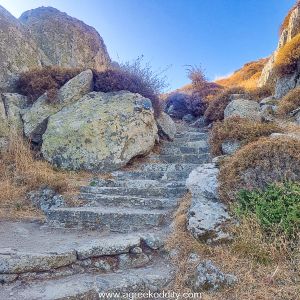
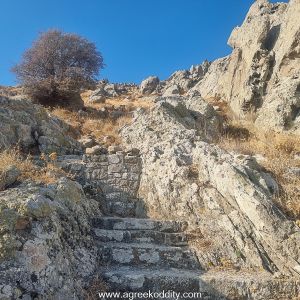
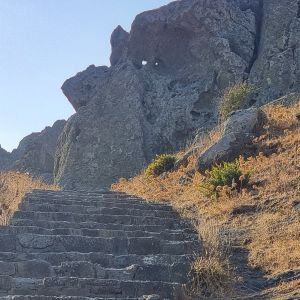
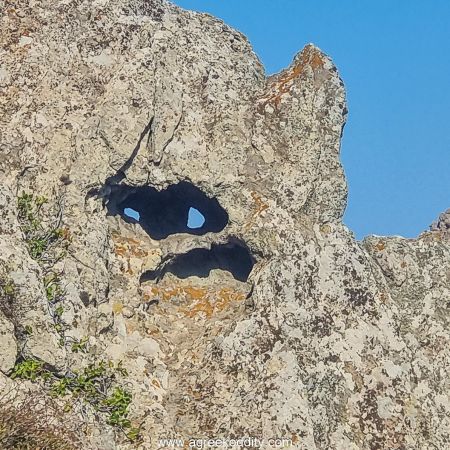
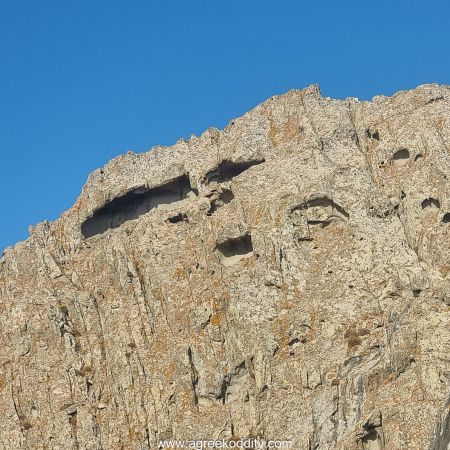
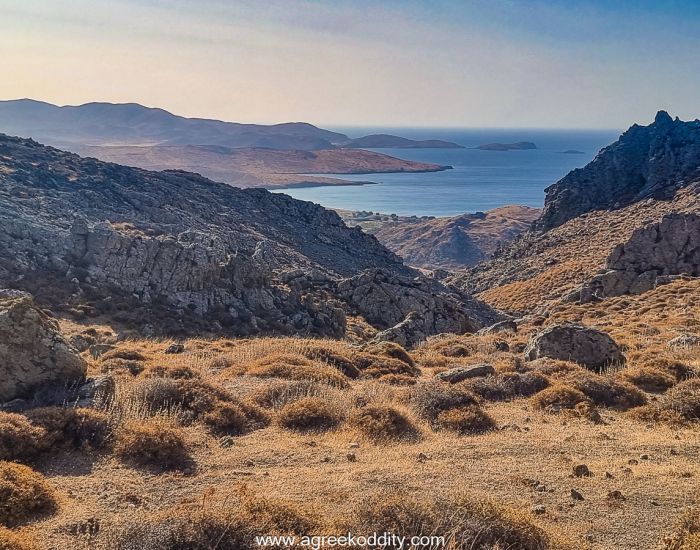

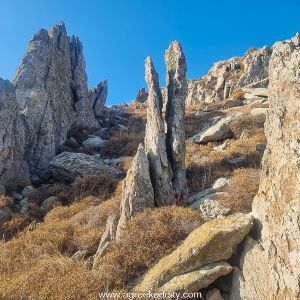
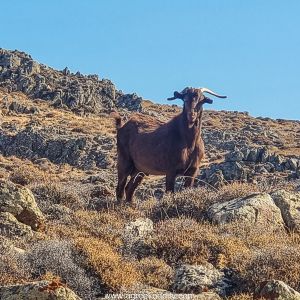

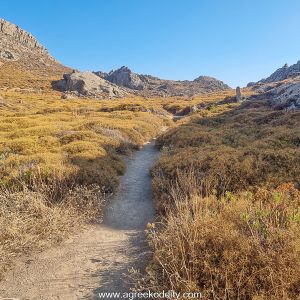


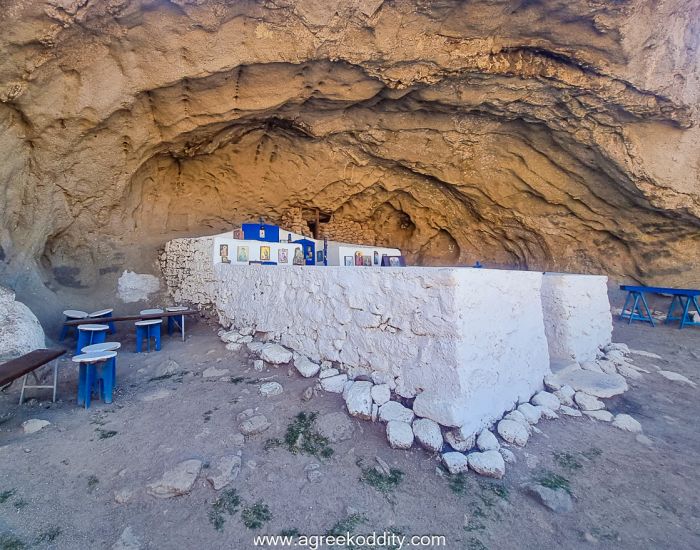
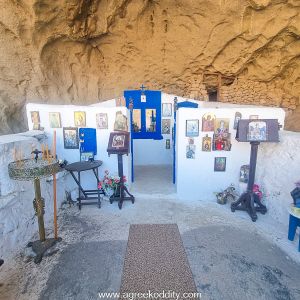
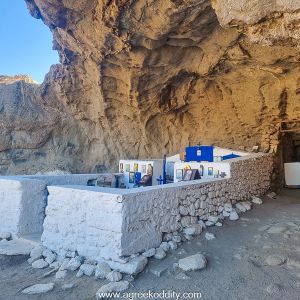



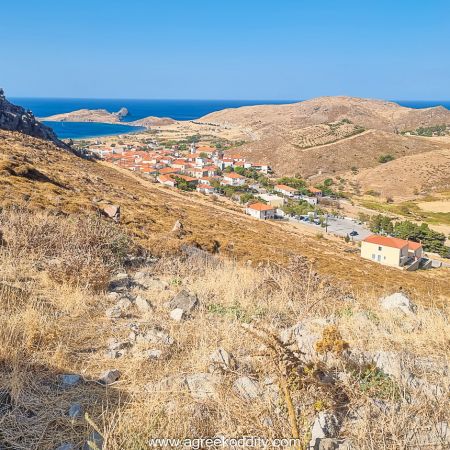
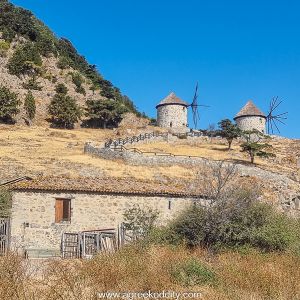
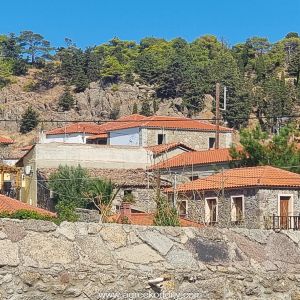


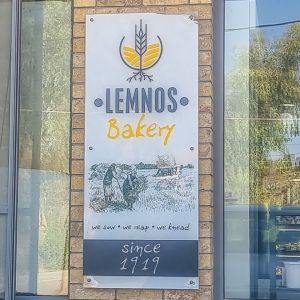
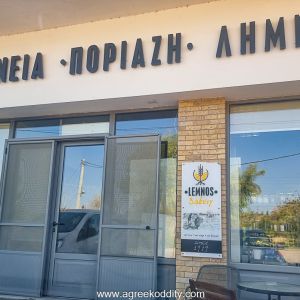
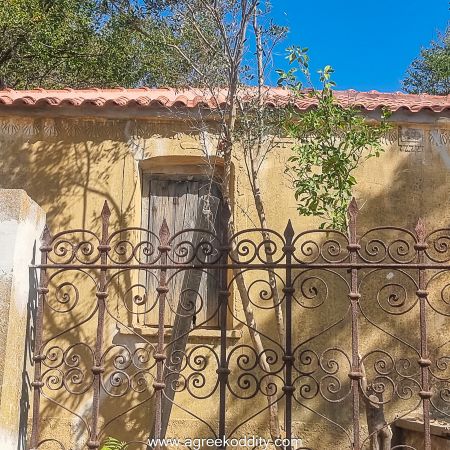
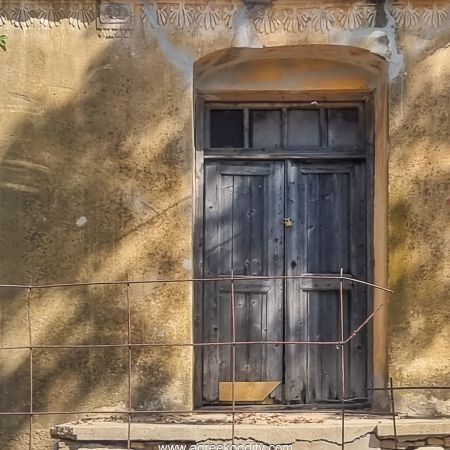

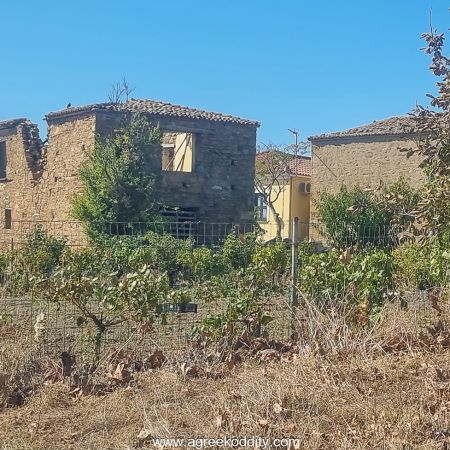
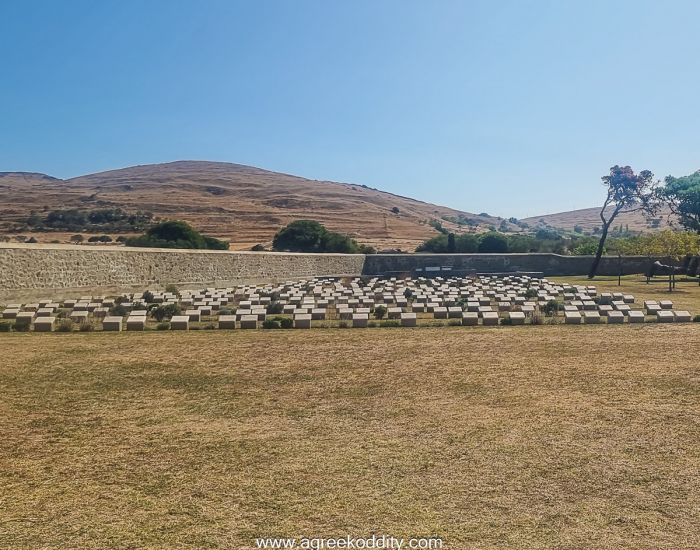

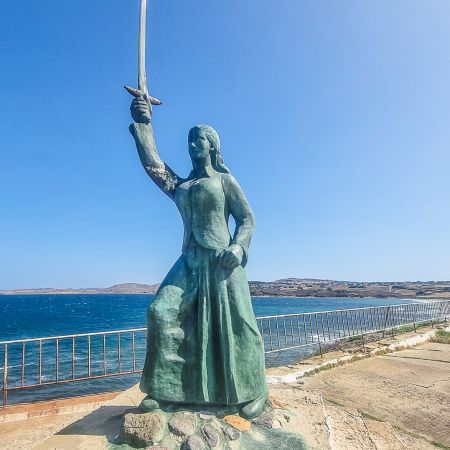
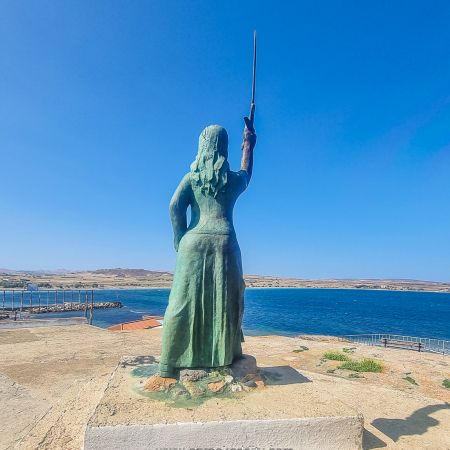
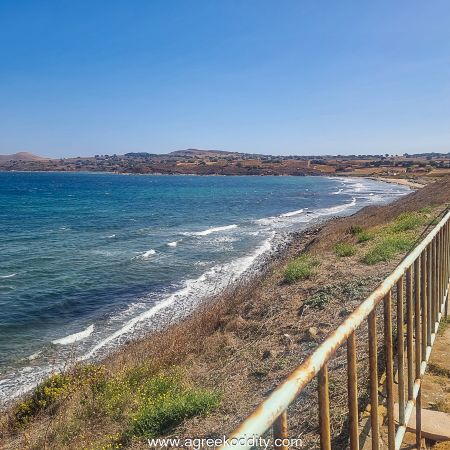
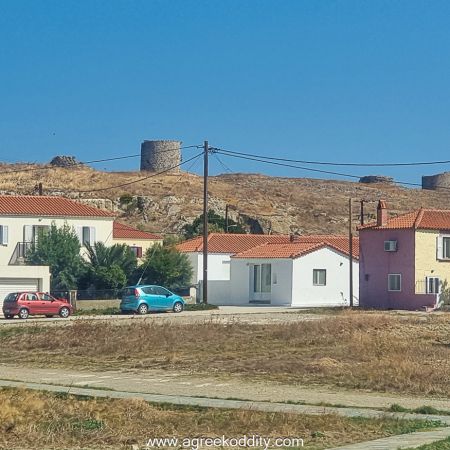
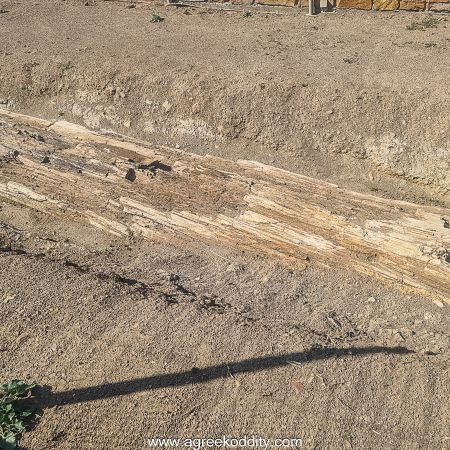
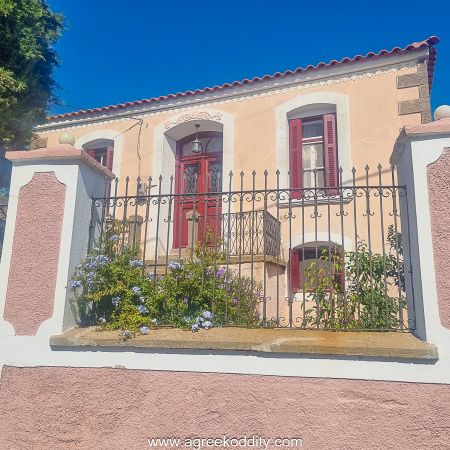
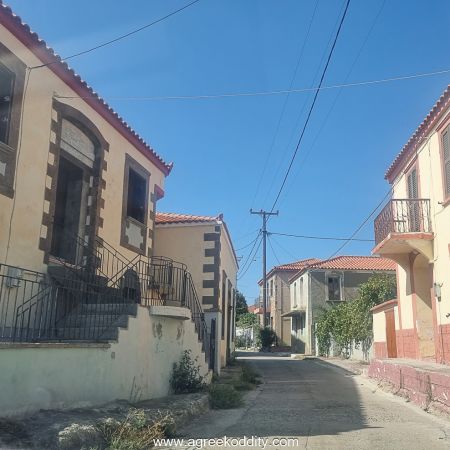
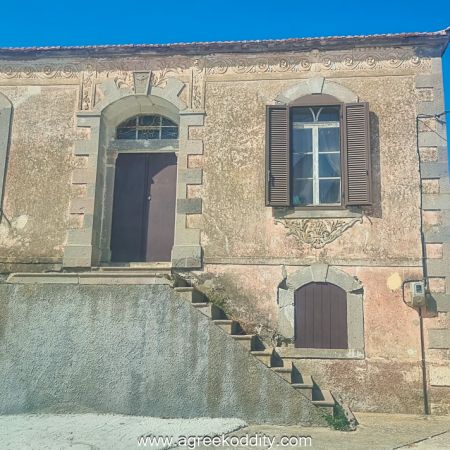



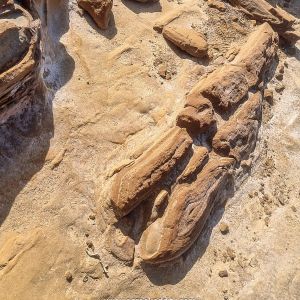

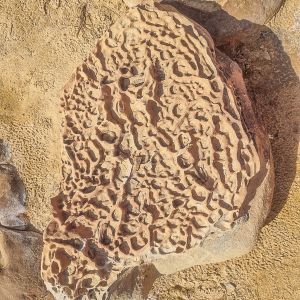

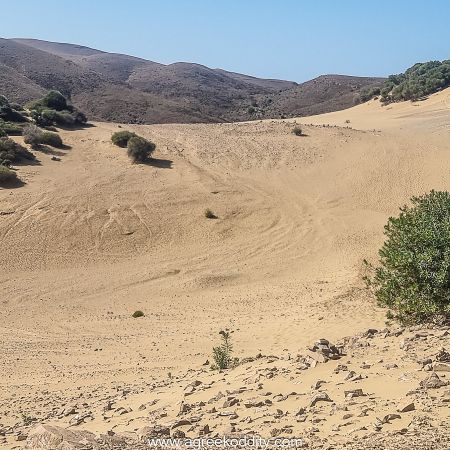
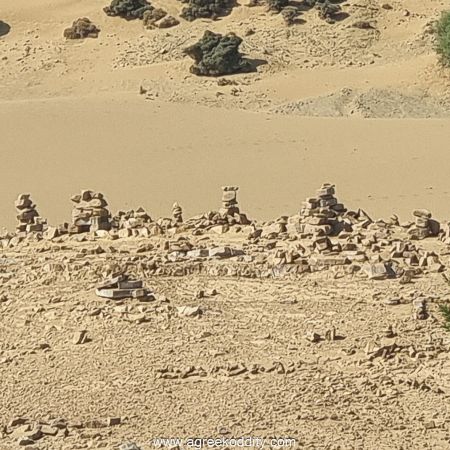
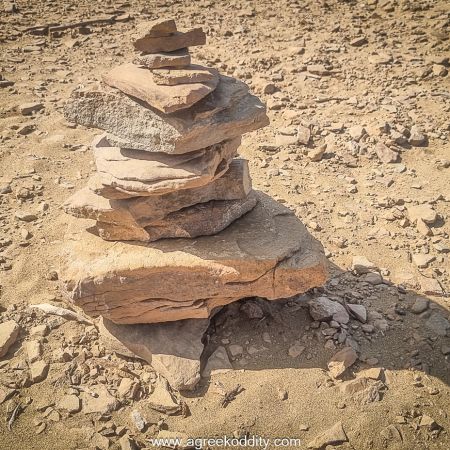







What an interesting read – Lemnos isn’t an island I knew anything about. The war history is interesting too, seeing the pictures of the war cemetery reminded me of my visit to the one on Leros near Alinda.
Lemnos is a truly special island. I think you need to be prepared to hire a car to see the island’s treasures though – I’d love to go back and do that. ❤